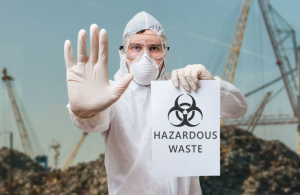Transporting hazardous materials is a complex process that requires strict adherence to safety regulations. Whether you’re a manufacturer, an industrial plant manager, or a building operator in Houston, understanding the intricacies of hazardous waste transportation is crucial for protecting your workers, the environment, and your business.
What Are Hazardous Materials?
Hazardous materials, often referred to as hazmat, are substances or materials that pose a risk to human health, safety, or the environment if not properly handled. These materials can range from chemicals and flammable liquids to radioactive substances and infectious agents.
The Department of Transportation (DOT) has established classifications for different types of hazardous materials to ensure their safe transportation.
Types of DOT Hazmat Classes
There are nine primary DOT hazmat classes:
- Explosives: Materials that can cause a sudden, almost instantaneous release of pressure, gas, and heat when subjected to a sudden shock, pressure, or high temperature.
- Gases: Compressed, liquefied, or dissolved gases that can be flammable, non-flammable, toxic, or corrosive.
- Flammable Liquids: Liquids that have a flash point of not more than 60°C (140°F).
- Flammable Solids: Solids that are readily combustible or may cause or contribute to fire through friction.
- Oxidizing Substances and Organic Peroxides: Substances that release oxygen and can cause or enhance the combustion of other materials.
- Toxic and Infectious Substances: Substances that are poisonous or can cause diseases in humans or animals.
- Radioactive Materials: Materials that emit radiation.
- Corrosive Substances: Substances that can cause severe damage when in contact with living tissue or can materially damage other goods.
- Miscellaneous Dangerous Goods: Substances that present a danger not covered by other classes, such as environmentally hazardous substances.
Transportation of Hazardous Materials
The selection of an appropriate transportation method for hazardous materials is a complex decision influenced by several critical factors:
Nature of the Hazardous Material
The physical and chemical properties of the material dictate the type of containment, handling procedures, and necessary safety precautions. For example, highly flammable liquids require specialized tankers, while corrosive substances necessitate corrosion-resistant containers.
Quantity
The volume of material being transported influences the choice of mode. Smaller quantities may be suitable for trucks, while larger volumes often necessitate rail or marine transport due to their higher capacity.
Distance
The distance the material must travel plays a significant role. Trucks are generally favored for shorter distances due to their flexibility and accessibility, while rail and marine transport excel at covering long distances more efficiently. Air transport, though the fastest, is usually reserved for extremely time-sensitive or high-value hazardous materials due to its high cost.
Cost
Economic considerations are paramount. Each mode of transport has distinct cost structures, including fuel, labor, insurance, and specialized equipment requirements. Balancing cost-effectiveness with safety and efficiency is crucial.
Regulatory Compliance
Stringent regulations govern the transportation of hazardous materials at both national and international levels. These regulations dictate packaging, labeling, documentation, and specific handling procedures to mitigate risks. Compliance is non-negotiable to ensure public safety and environmental protection.
Common Transportation Methods
- Motor Vehicles (Trucks): Trucks are the workhorses of hazardous material transportation for shorter distances and smaller quantities. They offer flexibility in routing and scheduling, making them adaptable to diverse needs. However, they have limited capacity compared to other modes.
- Rail Transport: Rail is ideal for long-distance, high-volume shipments. Trains can haul vast quantities of hazardous materials safely and efficiently, minimizing the number of individual shipments required. However, rail infrastructure and accessibility may be limiting factors.
- Marine Vessels (Ships): Ships are essential for transoceanic or coastal transport of hazardous materials. They boast immense cargo capacity, making them suitable for bulk shipments. However, maritime transport is subject to weather conditions and port restrictions.
- Air Transport: Air transport is the fastest option, making it invaluable for time-critical shipments, such as medical isotopes or emergency response supplies. However, air transport is costly and has strict limitations on the types and quantities of hazardous materials allowed.
Safety First
Regardless of the chosen mode, the safe handling and containment of hazardous materials during transit are paramount. Each transportation method has specific safety protocols and requirements to prevent accidents, leaks, spills, or exposure to harmful substances. This includes specialized training for personnel, emergency response plans, and rigorous inspections of vehicles and containers.
Reliable Hazardous Waste Transportation and Disposal with Specialized Waste Systems
Navigating the complex regulations surrounding hazardous waste transportation can be daunting. That’s where Specialized Waste Systems comes in. We’re a Houston-based total waste management company specializing in the safe and compliant transportation of hazardous and non-hazardous waste.
Our team of experts is well-versed in DOT regulations and has the experience and resources to handle a wide range of hazardous materials. We offer comprehensive transportation solutions, including:
- Secure Packaging and Labeling: We ensure your hazardous waste is properly packaged and labeled according to DOT regulations.
- Specialized Vehicles and Equipment: Our fleet of vehicles is equipped to safely transport various types of hazardous materials.
- Trained and Certified Personnel: Our drivers and technicians are trained and certified in hazardous materials handling and transportation.
- Emergency Response: We have emergency response procedures in place to address any unforeseen incidents during transport.
Partnering with Specialized Waste Systems means peace of mind knowing your hazardous waste is being handled responsibly and in full compliance with all relevant regulations.




